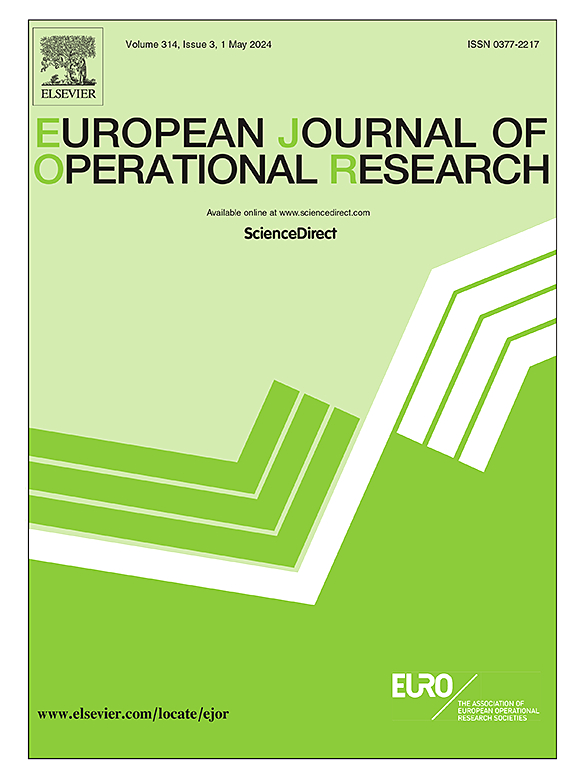Multi-cycle production network design under supply uncertainty
IF 6
2区 管理学
Q1 OPERATIONS RESEARCH & MANAGEMENT SCIENCE
引用次数: 0
Abstract
This study addresses a novel production network design problem with an expanded scope inspired by a real-world business context. The problem involves strategic decisions for a long-term horizon regarding production sites’ location and capacity, suppliers’ selection, and transportation modes choice, given in-house vs external service providers’ options. To support these decisions, we integrate key tactical decisions for a large set of planning periods, involving flows between origin–destination pairs, production levels based on bill of materials, and inventory levels. Additionally, we consider uncertainty in raw material availability at suppliers, disruption in production capacities, and perturbation in transportation flows. First, we develop a multi-stage stochastic program that re-optimizes strategic decisions at each design period. Then, this program is reformulated into a multi-cycle two-stage stochastic model. Uncertainty is modeled through a finite set of scenarios generated using the Latin hypercube sampling technique, and the sample average approximation method is used to calibrate the sample size. Given the challenging solvability of the model, we proposed an advanced solution approach that builds on the recently introduced Partial Benders Decomposition (PBD) technique with new scenario creation strategies. Our experiments highlight the superiority of the proposed PBD’s variant in terms of solution quality and time reaching the best solution, compared to classical approaches. Furthermore, we demonstrate the benefits of enlarging the scope of the production network design problem by integrating all strategic decisions, which can yield gains of up to 36% compared to addressing them separately. Finally, we underscore the importance of stochastic modeling, contributing to cost reductions of over 3% compared to the deterministic counterpart.供应不确定性下的多周期生产网络设计
本研究解决了一个新的生产网络设计问题,其扩展范围受到现实世界商业环境的启发。这个问题涉及到长期的战略决策,包括生产基地的位置和产能、供应商的选择和运输方式的选择,以及内部和外部服务提供商的选择。为了支持这些决策,我们集成了大量计划周期的关键战术决策,包括出发地-目的地对之间的流程、基于物料清单的生产水平和库存水平。此外,我们还考虑了供应商原材料供应的不确定性、生产能力的中断以及运输流的扰动。首先,我们开发了一个多阶段随机程序,在每个设计阶段重新优化战略决策。然后,将该方案重新表述为多周期两阶段随机模型。利用拉丁超立方采样技术生成的有限情景集对不确定性进行建模,并使用样本平均近似方法校准样本大小。鉴于该模型具有挑战性的可解性,我们提出了一种先进的解决方法,该方法基于最近引入的部分弯曲分解(PBD)技术和新的场景创建策略。与经典方法相比,我们的实验突出了所提出的PBD变体在解决方案质量和达到最佳解决方案的时间方面的优势。此外,我们展示了通过整合所有战略决策来扩大生产网络设计问题范围的好处,与单独解决这些问题相比,这可以产生高达36%的收益。最后,我们强调了随机建模的重要性,与确定性模型相比,它有助于降低超过3%的成本。
本文章由计算机程序翻译,如有差异,请以英文原文为准。
求助全文
约1分钟内获得全文
求助全文
来源期刊

European Journal of Operational Research
管理科学-运筹学与管理科学
CiteScore
11.90
自引率
9.40%
发文量
786
审稿时长
8.2 months
期刊介绍:
The European Journal of Operational Research (EJOR) publishes high quality, original papers that contribute to the methodology of operational research (OR) and to the practice of decision making.
 求助内容:
求助内容: 应助结果提醒方式:
应助结果提醒方式:


